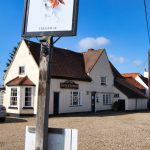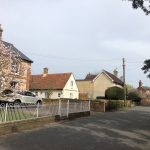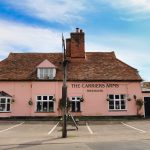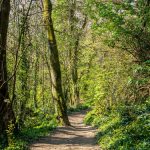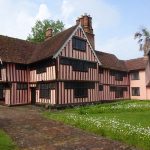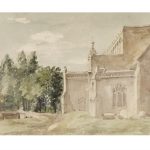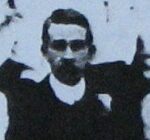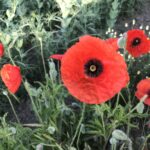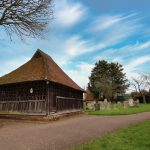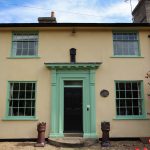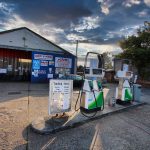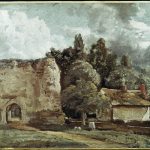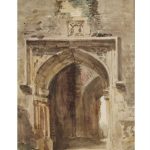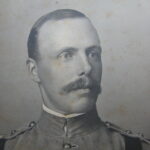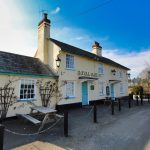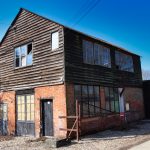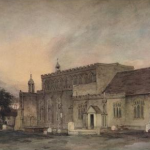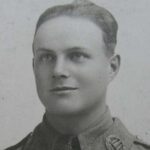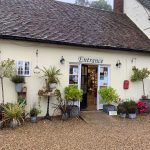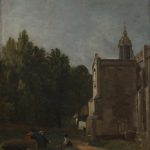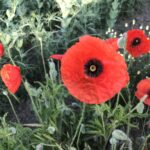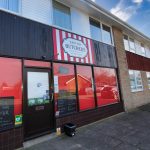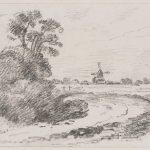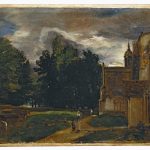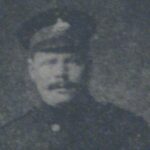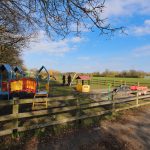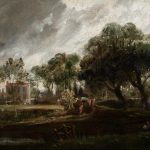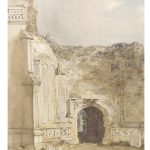A traditional Constable Country Pub
Monday-Saturday 1200-2300 | Sunday 1200-2230
Gaston Street has been an important thoroughfare in East Bergholt for centuries, linking the village centre and The Street in the south, with the area once known as Gaston End in the north, where it now adjoins the B1070. Today it lies on a bus route into the village and is a main access route. The street widens as it approaches the village centre.
Gaston Street is a primarily residential street with a wide variety of house types, sizes and styles. The two exceptions are Richardson’s farm which remains a working farm, with its listed farmhouse situated towards the northern end, and the single storey Lambe School, founded in 1594 and now used as a village hall, located closer to the village centre. The latter sits opposite some large houses built in classical style in the late 20th century.
Gaston Street remained largely undeveloped until Victorian times. In 1851 there were only 16 houses on Gaston Street with Tufnells located at one end and The Gothics at the other. Since then any gaps have been filled to provide an eclectic and interesting streetscape with 10 listed buildings scattered on both sides of the street intermixed with more modern development with a wide range of building styles. The street scene is enhanced by the number and type of large mature trees, many with TPOs.
A Territorial soldier, Joseph - as he was known to his family - was mobilised at the outbreak of the War in August 1914, but was too young then to be sent to fight overseas. He was sent to France in July 1916, and joined the 2nd Battalion of the Suffolk Regiment the following month. Joseph was Killed in Action on 16th August 1916, during the Battle of the Somme.
Country village pub and restaurant serving traditional pub food.
During WW2, nicknamed ‘Songthrust’ and in case of invasion of the Germans, The East Bergholt resistance operated from their underground base situated in woodland known as ‘The Commons’, about 15 metres off Dead Lane, originally a cart track but now a well used footbath to the west of the village bordering the A12.
A watercolour showing East Bergholt Church from the east under a sunny sky with a few small clouds. A group of trees stands in the distance on the left and it is inscribed on the back in pencil by the artist June 1806.
An Army Reservist, Algernon was sent to France in September 1914 and served with 2nd Battalion, the Essex Regiment. In July 1915, Algernon died of wounds he had received nearly two months earlier during the 2nd Battle of Ypres, leaving a wife and two children.
The second of the East Bergholt men to die in the Great War, Ernest was an Army Reservist. He was sent to France at the outbreak of the War in August 1914, where he served with 2nd Battalion, the Suffolk Regiment. He died of wounds on 6th October 1914, leaving a wife and 3 children.
Work on the Bell Tower of St Mary The Virgin Church began in 1525 with the assistance of Cardinal Wolsey, however with his downfall cut short, all work ceased in 1530 and the Bell Cage was erected as a temporary measure in 1531.
Local garage able to carry out general vehicle repairs, servicing, MOTs etc.
The Garage also houses the East Bergholt "Bike Doctor", (opening times the same as Garage).
Although the exact year is unknown, this sketch depicts the ruined tower at the West end of St Mary's Church, East Bergholt.
This watercolour of the south archway of the ruined tower was painted during Constable’s visit to East Bergholt in June 1806 prior to his 2 month trip to Windemere and is the only watercolour from this visit with a precise date.
Father of Michael Barthorp. Arthur was a retired Army Officer, who was recalled upon the outbreak of War in August 1914. At the time of his death from natural causes, he commanded the Northamptonshire Regiment’s Depot in Northampton. He was survived by his wife, and a son – two other sons having pre-deceased him.
Opening hours
Sunday-Thursday 1200-2200
Friday-Saturday 1200-2300
W T Wheeler & Sons were builders and joiners based at Wheelers Yard, better known as Pakefield works (now Suffolk Sheds) at the end of Putticks Lane, and built many well known properties around the village including Constable Hall and the Primary School.
East Bergholt Church, from the south side and clearly showing a doorway and porch to almost the centre of the sketch that no longer exists.
Son of Arthur Barthorp. In August 1914, Michael was a Cadet at the Royal Military College at Sandhurst. He subsequently joined his father’s old Regiment – the Northamptonshire Regiment.- and served with their 1st Battalion in France. Michael was killed in action during the Battle of the Somme, and is one of many thousands who have no known grave.
Fabulous cafe and quirky gift shop in the heart of Constable Country.
Monday - closed
Tuesday-Saturday 1000-1600
Sunday - closed
This is believed to be the first oil painting that Constable exhibited, A Church Porch, which Constable sent to the British Institute in 1811, noting: The ‘Porch’ is that of Bergholt Church, and the stillness of a summer afternoon is broken only by the voice of an old man, to whom a woman and a girl sitting on one of the tombs are listening.
James was working as a Postman at the time he was conscripted into the Army in 1916. He was formally “called up” the following year and served in France with 11th Battalion, the South Lancashire Regiment. James was killed in action near the town of Ham, on the third day of the great German Offensive in March 1918.
A family run butchers at East End
Monday - closed
Tuesday-Thursday 0900-1500
Friday -0900-1600
Saturday - 0900-1300
Sunday - closed
The Windmill which was located on the old heath at ‘Windmill Bank’, part of ‘Pitts Farm’ which extended east of the Donkey Track to the fields up to Gandish Road and across to what is now Mill | Heath Road & Gandish|Straight Road
With the moon rising, or the sun setting behind the porch, three figures walk on the path leading to the porch.
The canvas has been relined at an unknown date and the new stretcher inscribed ‘Church Porch evening’.
Herbert served in France with the 4th Battalion of the Suffolk Regiment. He was captured by the Germans during the Battle of Arras in 1917 and died just over 3 years later, from ill health attributed to his time as a Prisoner of War in Germany. Herbert was buried with full military honours in East Bergholt Cemetery.
Playing fields and playground off the Gandish Road.
car parking available
nearest public toilets - village centre
East Bergholt House, home of the Constables, demolished C1840.
All that remains is that of the Coach House, Laundry and stable block, known today as The Court (private residence)
Images of ruins were a recurrent theme in Romantic art and literature and therefore can be difficult to date given the manner of use of watercolour. Inscribed on the back in pencil 'East Bergholt Church' it is believed this was painted between 1805-1811 as when compared to the earlier work 'East Bergholt Church' C1805, the medium is handled with less freedom and confidence.

